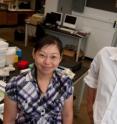'Freaky mouse' defeats common poison
Over millennia, mice have thrived despite humanity's efforts to keep them at bay. A Rice University scientist argues some mice have found two ways to achieve a single goal -- resistance to common poison. New research by Michael Kohn and colleagues, reported today in the online journal Current Biology, analyzes a genetic mutation that has given the ordinary European house mouse this extraordinary ability.
The gene in question, vkorc1, is present in all mammals and manages vitamin K. A mutation to vkorc1 makes mice resistant to warfarin, an anticoagulant used as a blood thinner in people as well as rodent poison.
Kohn, an associate professor of ecology and evolutionary biology at Rice, said the mice evolved to become poison-resistant following two distinct processes. In one, point mutation, genes adapt through spontaneous mutations during DNA replication. Algerian mice (Mus spretus), a desert-dwelling, seed-eating species, probably acquired the mutation this way to counter a vitamin K-deficient diet, Kohn said.
Evolution through point mutation is a textbook example of how populations adapt to new environments, he said. Because rodents reproduce so quickly, their adaptation to warfarin is one of the few that can be observed directly during the lifetimes of evolutionary geneticists. The poisons were introduced in the early 1950s, and poison-resistant rodents began to appear in the 1960s.
The other process, horizontal gene transfer, is generally associated with microbes, not mammals, and has never been documented at the level of detail the new paper offers, Kohn said. Here, resistance seems to have been transferred directly from Algerian mice to European house mice (Mus musculus domesticus).
"A key element of this study is that we've caught evolution in the act," he said.
Mutated vkorc1 has been the subject of many studies, including one by Kohn that illustrated a downside all too familiar to humans, the risk of arterial calcification and osteoporosis.
A rodent pest-control specialist treating the basement of a German bakery found the first evidence that house mice had developed resistance to warfarin. "He said, 'I cannot kill these mice with bromadiolone,' a nasty version of warfarin," said Kohn, whose lab was asked to sequence mice for vkorc1. (He noted pest-control professionals have a variety of weapons to eliminate even warfarin-resistant species.)
Kohn reacted with disbelief when he looked at the sequences. "I said, 'This cannot be a common house mouse. What type of animal did you send me here?'"
Vkorc1 seemed out of place, he said. "The gene sequence was identical to Mus spretus, which looks similar to house mice but does not normally occur in Germany," he said. "We could see that a big chunk of their DNA looked like Mus spretus. But genetically, these obscure bromadiolone-resistant mice looked like ordinary house mice. This is a freaky mouse."
Kohn and colleagues speculated Algerian mice passed the resistant genome into house mice in Spain or North Africa deserts, where the species overlap geographically.
"In the very distant past, these mice wouldn't even meet," he said. "With the spread of agriculture thousands of years ago in the Fertile Crescent, humans brought mice with them -- unwillingly. That brought these two types of mice into contact, and they started doing their thing, hybridizing here and there."
Hybridization is usually an evolutionary dead end, because at least 50 percent of hybrid offspring mice are sterile. "Nature doesn't think hybrids are very useful unless something special happens, such as some sort of environmental change," Kohn said. "But on the rare occasion -- and I think we are the first to show this in an animal -- hybridization leads to a combination that is advantageous."
The sudden introduction of warfarin in the 1950s may have triggered the usually doomed hybrids to further adapt "by exploring the repertoire of mutations in the vkorc1 gene and also by experimenting with a copy of vkorc1 from Mus spretus," Kohn said.
"The fundamental question now is: Is this so difficult to accomplish that it only happened once, or is it so easy that it has happened on numerous occasions in numerous places?"
Kohn and his colleagues are in a unique position to see which version of resistance might prevail -- point mutation or gene transfer -- and whether mice will suffer the same arterial calcification as the mutant rats in Kohn's previous study.
"We may need to embrace the fact that animals are just as versatile as microbes and plants in developing new traits through hybridization," said Kohn, who expressed concern that humans' desire to kill a species only made the species stronger.
"The human factor in this study is quite clear," he said. "One of the gravest concerns to conservation of biodiversity is the inadvertent spread of invasive species across the globe. In this study, this test came in the form of our desire to extirpate so-called pest species with poisons, which we use to get rid of microbes, bugs, weeds and even some mammals."
Source: Rice University
Articles on the same topic
- With secondhand gene, house mice resist poisonThu, 21 Jul 2011, 18:36:16 UTC
Other sources
- Some Mice Have Become Immune to Poison Through Natural but Highly Unusual Evolutionfrom PopSciFri, 22 Jul 2011, 16:31:06 UTC
- With secondhand gene, 'freaky mouse' defeats common poisonfrom PhysorgThu, 21 Jul 2011, 20:00:42 UTC
- 'Freaky' mouse is immune to deadly poisonfrom MSNBC: ScienceThu, 21 Jul 2011, 20:00:23 UTC
- 'Freaky mouse' defeats common poison: House mice found unexpected ways to evolve resistance, study showsfrom Science DailyThu, 21 Jul 2011, 18:30:38 UTC
- With secondhand gene, house mice resist poisonfrom Science DailyThu, 21 Jul 2011, 18:30:36 UTC
- Freaky Mutant Mouse Steals Genes to Resist Poisonfrom Live ScienceThu, 21 Jul 2011, 17:30:29 UTC
- 'Bastard' Mouse Steals Poison Resistance Genefrom Science NOWThu, 21 Jul 2011, 17:10:07 UTC

